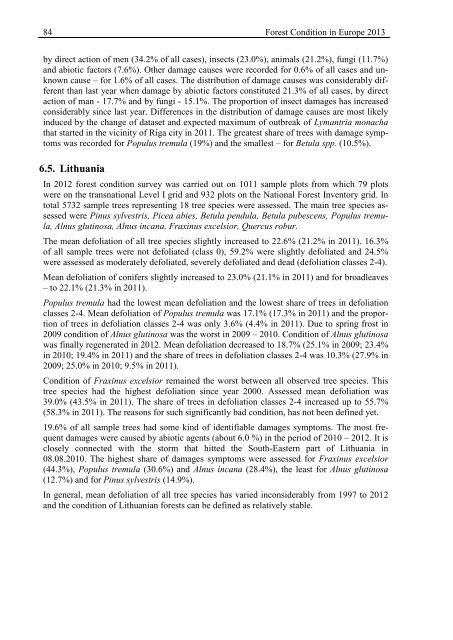Forest Condition in Europe - ICP Forests
Forest Condition in Europe - ICP Forests
Forest Condition in Europe - ICP Forests
Create successful ePaper yourself
Turn your PDF publications into a flip-book with our unique Google optimized e-Paper software.
84 <strong>Forest</strong> <strong>Condition</strong> <strong>in</strong> <strong>Europe</strong> 2013<br />
by direct action of men (34.2% of all cases), <strong>in</strong>sects (23.0%), animals (21.2%), fungi (11.7%)<br />
and abiotic factors (7.6%). Other damage causes were recorded for 0.6% of all cases and unknown<br />
cause – for 1.6% of all cases. The distribution of damage causes was considerably different<br />
than last year when damage by abiotic factors constituted 21.3% of all cases, by direct<br />
action of man - 17.7% and by fungi - 15.1%. The proportion of <strong>in</strong>sect damages has <strong>in</strong>creased<br />
considerably s<strong>in</strong>ce last year. Differences <strong>in</strong> the distribution of damage causes are most likely<br />
<strong>in</strong>duced by the change of dataset and expected maximum of outbreak of Lymantria monacha<br />
that started <strong>in</strong> the vic<strong>in</strong>ity of Riga city <strong>in</strong> 2011. The greatest share of trees with damage symptoms<br />
was recorded for Populus tremula (19%) and the smallest – for Betula spp. (10.5%).<br />
6.5. Lithuania<br />
In 2012 forest condition survey was carried out on 1011 sample plots from which 79 plots<br />
were on the transnational Level I grid and 932 plots on the National <strong>Forest</strong> Inventory grid. In<br />
total 5732 sample trees represent<strong>in</strong>g 18 tree species were assessed. The ma<strong>in</strong> tree species assessed<br />
were P<strong>in</strong>us sylvestris, Picea abies, Betula pendula, Betula pubescens, Populus tremula,<br />
Alnus glut<strong>in</strong>osa, Alnus <strong>in</strong>cana, Frax<strong>in</strong>us excelsior, Quercus robur.<br />
The mean defoliation of all tree species slightly <strong>in</strong>creased to 22.6% (21.2% <strong>in</strong> 2011). 16.3%<br />
of all sample trees were not defoliated (class 0), 59.2% were slightly defoliated and 24.5%<br />
were assessed as moderately defoliated, severely defoliated and dead (defoliation classes 2-4).<br />
Mean defoliation of conifers slightly <strong>in</strong>creased to 23.0% (21.1% <strong>in</strong> 2011) and for broadleaves<br />
– to 22.1% (21.3% <strong>in</strong> 2011).<br />
Populus tremula had the lowest mean defoliation and the lowest share of trees <strong>in</strong> defoliation<br />
classes 2-4. Mean defoliation of Populus tremula was 17.1% (17.3% <strong>in</strong> 2011) and the proportion<br />
of trees <strong>in</strong> defoliation classes 2-4 was only 3.6% (4.4% <strong>in</strong> 2011). Due to spr<strong>in</strong>g frost <strong>in</strong><br />
2009 condition of Alnus glut<strong>in</strong>osa was the worst <strong>in</strong> 2009 – 2010. <strong>Condition</strong> of Alnus glut<strong>in</strong>osa<br />
was f<strong>in</strong>ally regenerated <strong>in</strong> 2012. Mean defoliation decreased to 18.7% (25.1% <strong>in</strong> 2009; 23.4%<br />
<strong>in</strong> 2010; 19.4% <strong>in</strong> 2011) and the share of trees <strong>in</strong> defoliation classes 2-4 was 10.3% (27.9% <strong>in</strong><br />
2009; 25.0% <strong>in</strong> 2010; 9.5% <strong>in</strong> 2011).<br />
<strong>Condition</strong> of Frax<strong>in</strong>us excelsior rema<strong>in</strong>ed the worst between all observed tree species. This<br />
tree species had the highest defoliation s<strong>in</strong>ce year 2000. Assessed mean defoliation was<br />
39.0% (43.5% <strong>in</strong> 2011). The share of trees <strong>in</strong> defoliation classes 2-4 <strong>in</strong>creased up to 55.7%<br />
(58.3% <strong>in</strong> 2011). The reasons for such significantly bad condition, has not been def<strong>in</strong>ed yet.<br />
19.6% of all sample trees had some k<strong>in</strong>d of identifiable damages symptoms. The most frequent<br />
damages were caused by abiotic agents (about 6.0 %) <strong>in</strong> the period of 2010 – 2012. It is<br />
closely connected with the storm that hitted the South-Eastern part of Lithuania <strong>in</strong><br />
08.08.2010. The highest share of damages symptoms were assessed for Frax<strong>in</strong>us excelsior<br />
(44.3%), Populus tremula (30.6%) and Alnus <strong>in</strong>cana (28.4%), the least for Alnus glut<strong>in</strong>osa<br />
(12.7%) and for P<strong>in</strong>us sylvestris (14.9%).<br />
In general, mean defoliation of all tree species has varied <strong>in</strong>considerably from 1997 to 2012<br />
and the condition of Lithuanian forests can be def<strong>in</strong>ed as relatively stable.
















